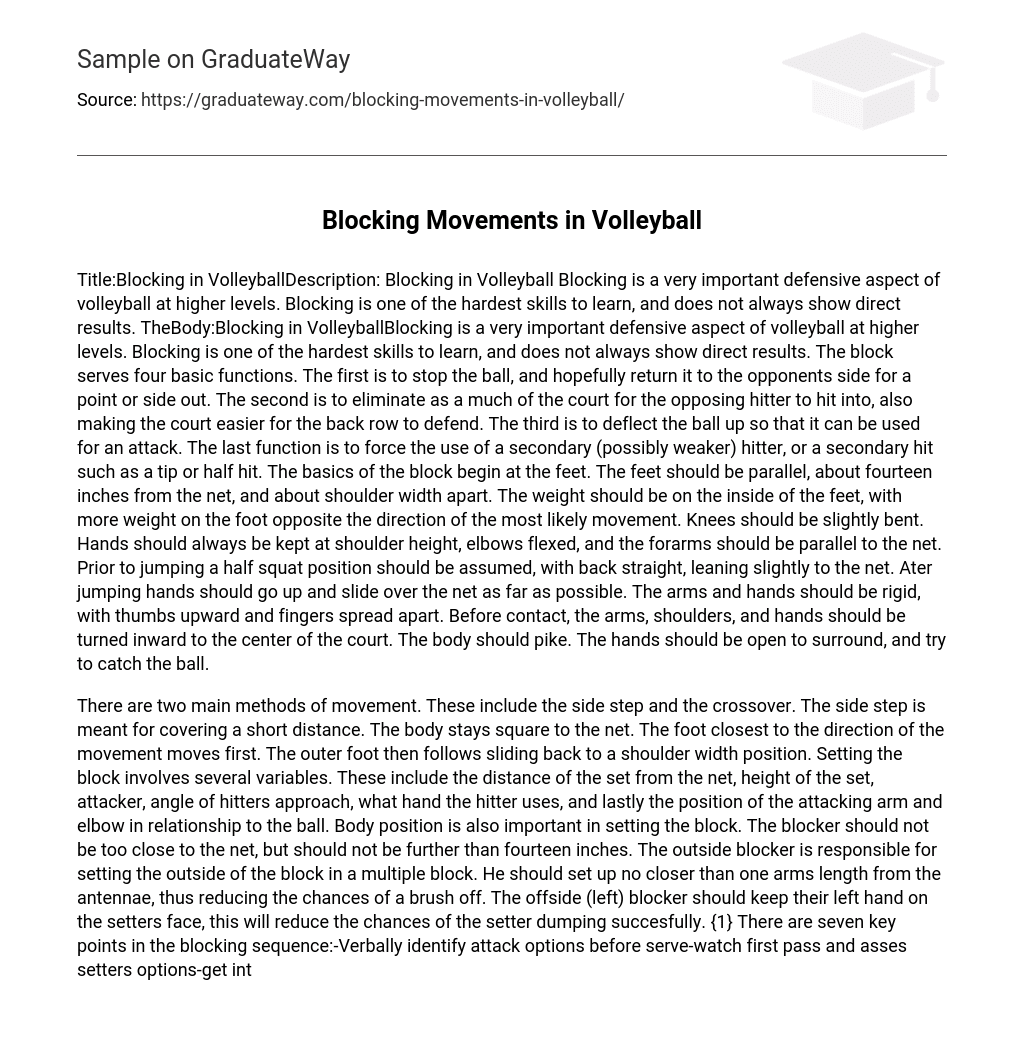Blocking is a crucial defensive skill in volleyball, particularly at higher levels. It can be challenging to master and may not always yield immediate results. The block serves multiple purposes. Firstly, it aims to halt the ball and ideally return it to the opponent’s side for a point or side out. Secondly, it seeks to reduce the available court space for the opposing hitter, thus making it easier for the back row to defend. Thirdly, it deflects the ball upwards, enabling it to be used for an attack. Lastly, it aims to compel the opposing team to rely on a secondary hitter, who may be weaker, or use a tip or half hit instead.
The block starts with the feet. They should be positioned parallel to each other, approximately fourteen inches from the net, and with a shoulder-width gap between them. The weight should be on the inside of the feet, placing more weight on the foot opposite the expected direction of movement. Knees should have a slight bend. Hands should always be maintained at shoulder height, with elbows flexed and forearms parallel to the net. Before jumping, adopt a half squat position with a straight back, leaning slightly towards the net. After jumping, extend your arms upward and slide them over the net as far as possible. Keep your arms and hands stiff, with thumbs pointed upward and fingers spread apart. Prior to making contact, rotate the arms, shoulders, and hands inward towards the center of the court. The body should be positioned in a pike shape. Keep your hands open and ready to surround or catch the ball.
There are two primary ways to move: the side step and the crossover. The side step is ideal for short distances, with the body facing the net. The foot closest to the movement’s direction moves first, followed by the outer foot sliding back to shoulder width position. Setting the block incorporates various factors, including the set’s distance from the net, set height, attacker, angle of hitter’s approach, hitter’s dominant hand, and the position of the attacking arm and elbow in relation to the ball. Body position is also crucial in setting the block, as the blocker should not be too close or more than fourteen inches away from the net.
The outside blocker’s role in a multiple block is to set up no closer than one arm’s length from the antennae, decreasing the likelihood of a brush off. The offside (left) blocker should keep their left hand on the setter’s face to minimize the setter’s chances of successfully dumping the ball.
Here are the six key points in the blocking sequence:
- verbally identify attack options before serve
- watch first pass and asses setters options
- get into position
- time the jump
- pike and press to opposite corner of court
- lock elbows after hitter has committed to adirection
Common mistakes in blocking include failing to penetrate the net, not fully closing the block, drifting past the hitter, and making contact with the net. To begin improving blocking skills, a basic drill called a stationary block is recommended. This involves someone acting as a hitter while positioned on a box or chair. By repeatedly hitting the ball in the same direction, athletes can develop their ability to block effectively. Through this drill, blockers can practice maintaining high hand position, keeping their eyes open, and actively going after the ball.
To improve footwork and make it more natural, blockers should practice their blocking movements while moving along the net. This helps them develop efficiency and balance. Another useful drill is the over the head drill, where the coach stands on the blockers’ side and tosses the ball over the net to the opposing hitter. This drill helps develop timing and the ability to adjust to where the ball is going, allowing the blockers to effectively front the hitter.
A technique to improve stability and control at the top of the net involves the coach throwing balls from the side of the net between four opposing blockers (two on each side). Their goal is to attempt a stuff block against each other. Blockin in volleyball is a challenging skill to learn and teach, and success is limited due to the rarity of a stuff block. However, blocking remains important when facing a strong hitting team.





